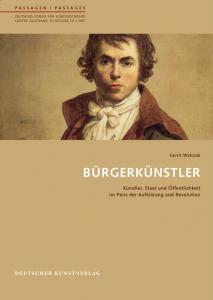Passagen
No. 45
Der Begriff des »artiste citoyen« wurde im Protest gegen ein vom Ancien Régime erlassenes Ausstellungsverbot geprägt. Er fasste den Künstler als Staatsbürger, der sich mit seinem Schaffen dem Wohl der gesamten Nation verschrieb. Nicht mehr der Beifall des Hofes, sondern die Anerkennung durch die öffentliche Meinung legitimierte seine Tätigkeit. Beredt kündet der »Bürgerkünstler« von einem vorrevolutionären Wandel, der sich den Salonausstellungen und einer zunehmend politisierten Kunstkritik verdankte. In dieser Perspektive Gerrit Walczaks bedeutete die Revolution für die Pariser Künstlerschaft keinen Bruch. Vielmehr traf 1789 eine jahrzehntelange Entwicklung auf Bedingungen, die den »Bürgerkünstlern« erstmals eine direkte politische Teilhabe ermöglicht.
Rezensionen:
Le concept de l’artiste-citoyen a pour origine une protestation à l’encontre d’une interdiction d’exposer promulguée par l’Ancien Régime. Il définissait l’artiste comme un citoyen qui se voue, par sa création, au bien de la nation tout entière. Ce n’est plus l’approbation de la Cour, mais la reconnaissance de l’opinion publique qui légitimait son activité. Le « citoyen- artiste » annonce avec éloquence une transformation pré-révolutionnaire qui résulte de l’exposition des œuvres lors des « salons » et d’une critique artistique de plus en plus politisée. Dans cette perspective, aux yeux de Gerrit Walczak, la Révolution ne constitue pas une rupture pour le monde artistique parisien. Selon lui, en 1789, une évolution qui avait duré plusieurs décennies rencontre des conditions qui, pour la première fois, permettent aux « citoyens-artistes » une participation politique directe.
Comptes-rendus :
The term “artiste citoyen” was coined in protest of the prohibition of exhibitions decreed by the Ancien Régime. It expressed the concept of the artist as a citizen who dedicates his life and work to the welfare of the entire nation. It was no longer the applause of the court, but recognition in the court of public opinion that legitimized their activity. The “artiste citoyen” eloquently heralded a pre-revolutionary transition that was precipitated in no small part by salon exhibitions and increasingly politicized art criticism. Paris artists, Gerrit Walczak concludes, did not see the revolution as a sudden break with the past. Rather, in 1789 a development decades in the making was catalyzed by conditions that enabled, for the first time, the direct political participation of the “artistes citoyens”.
Recensions:
Citation
Gerrit Walczak, Bürgerkünstler. Künstler, Staat und Öffentlichkeit im Paris der Aufklärung und Revolution, Berlin/München, Deutscher Kunstverlag, 2015 (Passagen/Passages, Bd. 45)







